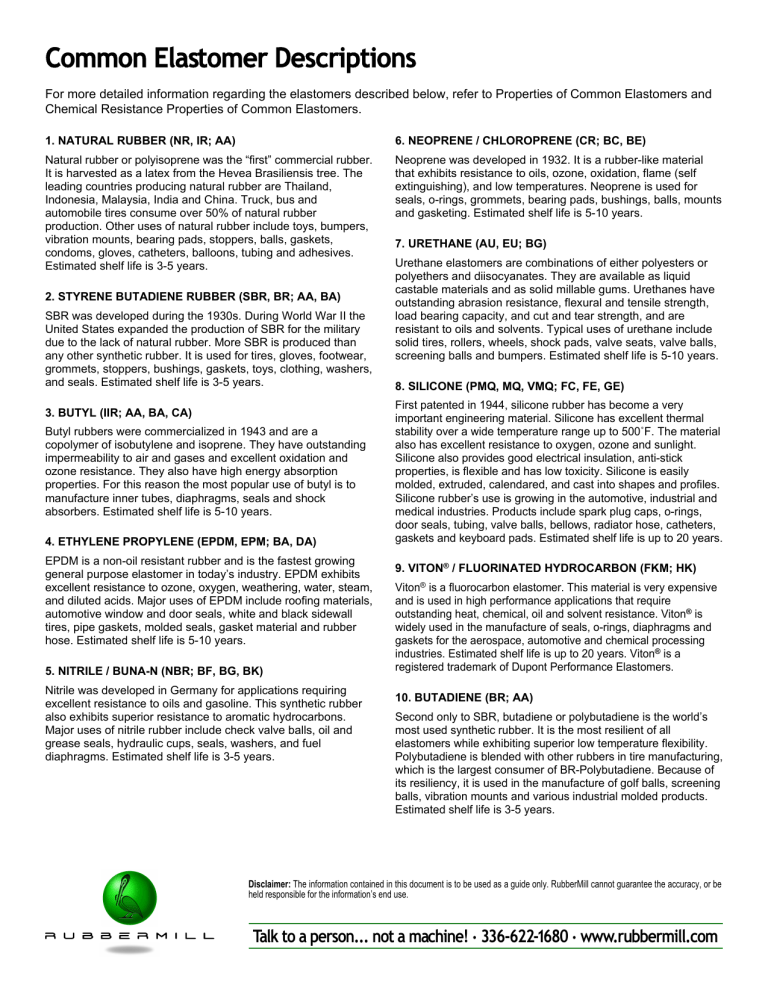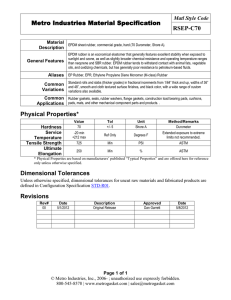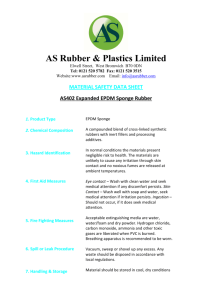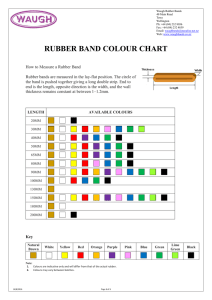Common Elastomer Descriptions

Common Elastomer Descriptions
For more detailed information regarding the elastomers described below, refer to Properties of Common Elastomers and
Chemical Resistance Properties of Common Elastomers.
1. NATURAL RUBBER (NR, IR; AA)
Natural rubber or polyisoprene was the “first” commercial rubber.
It is harvested as a latex from the Hevea Brasiliensis tree. The leading countries producing natural rubber are Thailand,
Indonesia, Malaysia, India and China. Truck, bus and automobile tires consume over 50% of natural rubber production. Other uses of natural rubber include toys, bumpers, vibration mounts, bearing pads, stoppers, balls, gaskets, condoms, gloves, catheters, balloons, tubing and adhesives.
Estimated shelf life is 3-5 years.
2. STYRENE BUTADIENE RUBBER (SBR, BR; AA, BA)
SBR was developed during the 1930s. During World War II the
United States expanded the production of SBR for the military due to the lack of natural rubber. More SBR is produced than any other synthetic rubber. It is used for tires, gloves, footwear, grommets, stoppers, bushings, gaskets, toys, clothing, washers, and seals. Estimated shelf life is 3-5 years.
3. BUTYL (IIR; AA, BA, CA)
Butyl rubbers were commercialized in 1943 and are a copolymer of isobutylene and isoprene. They have outstanding impermeability to air and gases and excellent oxidation and ozone resistance. They also have high energy absorption properties. For this reason the most popular use of butyl is to manufacture inner tubes, diaphragms, seals and shock absorbers. Estimated shelf life is 5-10 years.
4. ETHYLENE PROPYLENE (EPDM, EPM; BA, DA)
EPDM is a non-oil resistant rubber and is the fastest growing general purpose elastomer in today’s industry. EPDM exhibits excellent resistance to ozone, oxygen, weathering, water, steam, and diluted acids. Major uses of EPDM include roofing materials, automotive window and door seals, white and black sidewall tires, pipe gaskets, molded seals, gasket material and rubber hose. Estimated shelf life is 5-10 years.
5. NITRILE / BUNA-N (NBR; BF, BG, BK)
Nitrile was developed in Germany for applications requiring excellent resistance to oils and gasoline. This synthetic rubber also exhibits superior resistance to aromatic hydrocarbons.
Major uses of nitrile rubber include check valve balls, oil and grease seals, hydraulic cups, seals, washers, and fuel diaphragms. Estimated shelf life is 3-5 years.
6. NEOPRENE / CHLOROPRENE (CR; BC, BE)
Neoprene was developed in 1932. It is a rubber-like material that exhibits resistance to oils, ozone, oxidation, flame (self extinguishing), and low temperatures. Neoprene is used for seals, o-rings, grommets, bearing pads, bushings, balls, mounts and gasketing. Estimated shelf life is 5-10 years.
7. URETHANE (AU, EU; BG)
Urethane elastomers are combinations of either polyesters or polyethers and diisocyanates. They are available as liquid castable materials and as solid millable gums. Urethanes have outstanding abrasion resistance, flexural and tensile strength, load bearing capacity, and cut and tear strength, and are resistant to oils and solvents. Typical uses of urethane include solid tires, rollers, wheels, shock pads, valve seats, valve balls, screening balls and bumpers. Estimated shelf life is 5-10 years.
8. SILICONE (PMQ, MQ, VMQ; FC, FE, GE)
First patented in 1944, silicone rubber has become a very important engineering material. Silicone has excellent thermal stability over a wide temperature range up to 500˚F. The material also has excellent resistance to oxygen, ozone and sunlight.
Silicone also provides good electrical insulation, anti-stick properties, is flexible and has low toxicity. Silicone is easily molded, extruded, calendared, and cast into shapes and profiles.
Silicone rubber’s use is growing in the automotive, industrial and medical industries. Products include spark plug caps, o-rings, door seals, tubing, valve balls, bellows, radiator hose, catheters, gaskets and keyboard pads. Estimated shelf life is up to 20 years.
9. VITON
®
/ FLUORINATED HYDROCARBON (FKM; HK)
Viton
®
is a fluorocarbon elastomer. This material is very expensive and is used in high performance applications that require outstanding heat, chemical, oil and solvent resistance. Viton
®
is widely used in the manufacture of seals, o-rings, diaphragms and gaskets for the aerospace, automotive and chemical processing industries. Estimated shelf life is up to 20 years. Viton
®
is a registered trademark of Dupont Performance Elastomers.
10. BUTADIENE (BR; AA)
Second only to SBR, butadiene or polybutadiene is the world’s most used synthetic rubber. It is the most resilient of all elastomers while exhibiting superior low temperature flexibility.
Polybutadiene is blended with other rubbers in tire manufacturing, which is the largest consumer of BR-Polybutadiene. Because of its resiliency, it is used in the manufacture of golf balls, screening balls, vibration mounts and various industrial molded products.
Estimated shelf life is 3-5 years.
Disclaimer: The information contained in this document is to be used as a guide only. RubberMill cannot guarantee the accuracy, or be held responsible for the information’s end use.



